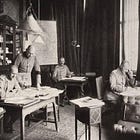The Division Command Post (Ic)
As seen by an American officer at the Kriegsakademie (1938)
On the eve of the Second World War, Albert Coady Wedemeyer of the US Army attended the Kriegsakademie in Berlin. Soon after completing, in July of 1938, the two-year course for future officers of the German General Staff, he submitted a pair of reports. The first of these provided a précis of the approach that the German Army took to tactics, leadership, and organization. The second described, in considerable detail, both the curriculum that he had followed and the ideal division featured in classroom exercises at the school
In the second report, the passage that describes the work of the intelligence section (Ic) reflects less in the way of hasty typing than the description of the work of the operations section (Ia) that precedes it. Thus, the text that follows bears such a close resemblance to the original that, rather than falling into the category of ‘paraphrase’, it might be described as an edited version of the list that Captain Wedemeyer included with his report.
Duties of the Intelligence Section (Ic)
Procures information about the enemy from such things as reconnaissance and goniometric intercept [radio direction-finding]. Evaluates, and promptly disseminates, the information received. Makes estimates of the enemy situation. Sets up a system of communications for intelligence reports. Conducts counter-intelligence activities to prevent the enemy from receiving information.
Maintains a map depicting the enemy situation. Differentiates between conjecture and confirmed information.
Prepares a daily resumé of enemy situation, including:
New Units or Weapons
New Construction and movements
Reserves
Replacements
Losses (killed and wounded)
Estimates of the enemy situation, his capabilities, and his intentions.
Makes suggestions for the employment of reconnaissance and other means of gathering information to clarify hostile situation. May prepare the paragraph pertaining to the enemy included in the field order.
Works closely together with the division signal officer in order to monitor enemy use of existing commercial nets and the meaning of signal rockets, flares, Very lights, and codes.
Conducts counter-espionage and protects against sabotage. Monitors enemy wire and radio communications.
Ensures that the spaces occupied by the intelligence section are located at some distance from those of the artillery commander and the division message center.1
Establishes observation posts.
Establish drop-off and pick-up stations on the landing fields used by liaison aircraft.
Supervises local security and camouflage, as well as the use of pass words, signs and countersigns and road signs.
Whenever the command post changes:
Insures that communications have been established and are prepared to operate in new command post before they are shut down in the old command post.
Arranges for the movement of the horses of the staff to the new command post.2
Arranges for the forwarding of messages from the old command post to the new one.
To be continued …
For Further Reading:
I suspect that separating the location of intelligence section from spaces occupied by the message center and the artillery commander preserves the former from undue reliance on the sort of transitory information that passes through the latter.
I would have thought that the movement of horses from one command post to another would have fallen into the bailiwick of the headquarters commandant. Indeed, it seems such an odd task for the intelligence section that I wonder if it was included by mistake in the list of duties of the intelligence section.






<sarc> Oh look a lost secret of the ancients; DF !
“Procures information about the enemy from such things as reconnaissance and goniometric intercept [radio direction-finding].”
<Sarc />
I think the hun might be on to something. Replace task 1 with "go to meetings" and task 2 with "scroll through 6 different chat windows" and I reckon they've cracked it.